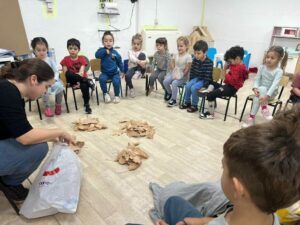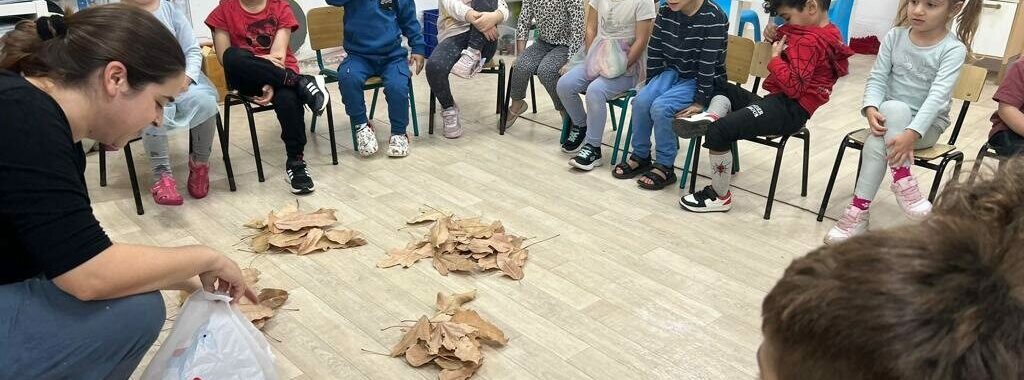By Andrew Adler
Community Editor

Jewish and Arab children sit in a classroom — once a communal bomb shelter — in the Gan Toot Living Together bilingual kindergarten at Kibbutz Evron in northern Israel
Five years ago a grand experiment sprouted in the Partnership2Gether Western Galilee region of Israel: a kindergarten on in which Jewish, Muslim, Christian and Druze children would attend while learning to speak Hebrew and Arabic. Founded on the longstanding Kibbutz Evron and dubbed Gan Toot (“Strawberry Gan” – which carries the same meaning in both languages) the community was founded on the principle that even in the most fraught of times, children of all faiths can thrive amid a multicultural, multiethnic environment.
That principle faced its severest test in the wake of Hamas’s October 7 murderous assaults on Israel. While those attacks occurred along the Gaza border in Southern Israel, the parallel threat from Hezbollah along Israel’s Northern border with Lebanon remains an ever-present concern. The Lebanese border is a mere six miles from the school, within easy range of Hezbollah’s rockets.
Despite these constant threats and post-October 7 disruptions, the kindergarten has carried on, undeterred and undaunted. The overall initiative, called Living Together, reflects trust and cooperation between Jews and Muslims living in close proximity to one another.
Gan Toot is a so-called NGO – a “non-governmental organization”– akin to a Western private school. “We, the parents, are involved in everything that goes on,” explains Shaked Mordechay, whose two young children have attended the school since its inception. “As members of the NGO, sometimes we upgrade the salaries of the teachers; sometimes we pick out the curriculum – things like that.”
It’s very different from Israel’s system of public education, which Mordechay says hews to more traditional lines. “You might say that the education system is segregated completely. Arabs learn with Arabs; Jews learn with Jews; religious Jews learn with religious Jews; and the Haredim – the ultra-Orthodox Jews – learn with themselves.”
Not so at Gan Toot. “We picked for our kids something different,” he says. “We wanted them to know their neighbors. So every (Jewish) preschooler is from Nahariya (Israel’s northernmost coastal city), or Kibbutz Evron, which is very close to Nahariya. The Arabs come from either Nahariya or Mazra’a, an Arab village nearby; and there are some from other kibbutzim.
“Most of the parents come to our preschool knowing that the agenda is to bring Arabs and Jews closer. Some parents just like the very good education system, which is considered far better than an ordinary city education system. So they go on a walk in the kibbutz, and everything feels safer, a lot like a small community.”
“We needed to something to bring Jews and Arabs together,” says Sagi Shelev, Living Together’s CEO. “So we organized a meeting in Mazra’a. I live in Kibbutz Evron, and there’s just a fence that separates us. From this came the idea to make something so our children will grow up differently.”
Shelev met a young Arab mother with a daughter the same age as his daughter. From there, “we started to bring in families who wanted their children to grow up together. We want our children to live together and speak the languages of each other and not to be afraid of each other. Even in how we celebrate holidays. For some of us, Independence Day is the biggest day because that’s when Israel was established – and for my friends who live in Mazra’a, it’s a horrible holiday.”
It soon became apparent that the parents had as much to learn as their children did. “My background was pushing me very hard,” Shelev says. “I lost my brother during the Second Lebanon War of 2006. At that time there were stickers that said, ‘We will win! We will win!’ but no – in a war, everybody loses. Some more and some less, but everybody – and we must find a way to live together and find solutions that are not war.”
War, though, has a way of pushing aside nobler considerations. Not surprisingly, security issues shot to the foreground of everyone’s consciousness after October 7. Gan Toot lacked a safe room capable of resisting the kind of assaults perpetuated by Hamas.
“When word broke on the 7th of October, it was obvious we could not open the preschool,” Modechay said, explaining that “most preschools on kibbutzim are in old buildings, without bomb shelters.
“Just for reference, there are two kinds of bomb shelters in Israel,” he explained. “There are the large public underground shelters, where the stairs are literally underground. And then you have the apartment sort of shelter, which is a safe room. It’s a room built from steel with a reinforced door. The windows have blast shields, so they are considered safe from rocket attacks. So we got approval from the kibbutz to transfer into a public shelter. They opened that shelter, maybe two floors down, and we transferred all the equipment and everything, and the kids went there for a month or so. Just this week, they got back to their original building, because we upgraded what we had.”
Gan Toot still needed a customized, secure safe room capable of accommodating 22 students, teachers and support staff. But because the school is an NGO, funds to design and build such a space would have to be raised privately.
An information sheet from Living Together puts it this way: “While new facilities in Israel are required by law to include an internal shelter, building a safe room in old buildings such as ours is done on a voluntary basis, and with no government support. At present, the kindergarten has only an old-fashioned security room, built in the 1980’s, and far from meeting today’s standards of threats.
“Due to our precarious geographic location, we had already been planning to construct such a safe room which meets today’s needs and regulatory requirements, funds permitting. Yet under the present circumstances, a safe room capable of meeting contemporary threats has become an immediate necessity.
“During the month of October, we were forced to completely pause the kindergarten’s activities, waiving the parents’ monthly (tuition) payments. Meanwhile, we continued to pay our staff’s salaries, adding a financial
burden to our mission. By November, we managed to partially reopen the kindergarten in a makeshift location, a bomb shelter in Kibbutz Evron. The next crucial step is to build a safe room/bomb shelter as part of the kindergarten structure, and for that we urgently seek funding.” The project is budgeted to cost approximately $61,000, of which about $13,000 has been raised so far.
October 7 was an extreme test of whether bonds of trust, established over the preceding five years, would hold.
“I work in a big hospital in Tel Aviv called Ichilov,” says supervisory nurse Kamel Hazbon, an Arab Gan Toot parent, “where all the time Arab and Jewish staff worked together in a good environment. But after the Seventh of October something was broken. Some of the Jewish staff started looking at Arab staff as if they were criminals, that they are Hamas, but we are not Hamas. We are against Hamas. This was the first time I was thinking of leaving Israel. I told my wife, ‘Why are we still here? Why should our children grow up in this environment? Let’s go to the U.S. or Canada and start over.’”
In time Hazbon’s anger and anxiety subsided. “After two months, everything was better,” he said. “And I’m so excited because my child, Majd, is now speaking Hebrew better than me.”




